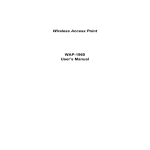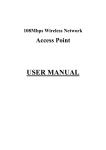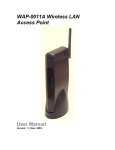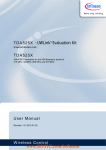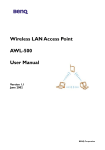Download Wireless Access Point User Manual
Transcript
Wireless Access Point User Manual Version 1.2 Instruction Manual Federal Communication Commission Interference Statement This equipment has been tested and found to comply with the limits for a Class B digital device, pursuant to Part 15 of the FCC Rules. These limits are designed to provide reasonable protection against harmful interference in a residential installation. This equipment generates, uses and can radiated radio frequency energy and, if not installed and used in accordance with the instructions, may cause harmful interference to radio communications. However, there is no guarantee that interference will not occur in a particular installation. If this equipment does cause harmful interference to radio or television reception, which can be determined by turning the equipment off and on, the user is encouraged to try to correct the interference by one of the following measures: - Reorient or relocate the receiving antenna. - Increase the separation between the equipment and receiver. - Connect the equipment into an outlet on a circuit different from that to which the receiver is connected. - Consult the dealer or an experienced radio/TV technician for help. FCC Caution: To assure continued compliance, (example – use only shielded ni terface cables when connecting to computer or peripheral devices). Any changes or modifications not expressly approved by the party responsible for compliance could void the user’s authority to operate this equipment. FCC Radiation Exposure Statement This equipment complies with FCC radiation exposure limits set forth for an uncontrolled environment. This equipment should be installed and operated with minimum distance 20 cm between the radiator & your body. This device complies with Part 15 of the FCC Rules. Operation is subject to the following two conditions: (1) This device may not cause harmful interference, and (2) this device must accept any interference received, including interference that may cause undesired operation. Table of Contents Chapter 1 Introduction 1 1.1 Package Contents 1 1.2 Features 1 1.3 System Requirement 1 Chapter 2 Connecting the Wireless Access Point to Your Network 2 Chapter 3 Configuring the Wireless Point 2 Chapter 4 Installing the USB Drivers for the Wireless Access Point 3 4.1 Installing the Driver software for Windows 98 3 4.2 Installing the Driver Software for Windows Millennium 5 4.3 Installing the Driver Software for Windows 2000 7 Chapter 5 Wireless Access Point Utility 5.1 Install Access Point Utility 11 11 5.2 Configuring the Wireless Access Point with USB Port / AP Utility 13 5.3 Configuring the Wireless Access Point with Ethernet Port / SNMP Utility 20 Chapter 6 Wireless Access Point Firmware Upgrade with Ethernet Port / TFTP Client Utility 28 Chapter 7 Application and Note 30 Chapter 8 Q & A 31 Wireless Access Point Chapter 1 Introduction Based on IEEE 802.11b, Wireless Access Points provide a cost effective way for mobile users to connect to their corporate Ethernet -based LANs. With the slick Windows based user interface designs, corporate IT specialists can easily deploy and manage Wireless Access Points in their environments. In addition to corporate uses, Wireless Access Points are for applications in public areas such as airports, hotels, fast-food restaurants, etc. People with mobile computers can use services offered by wireless Access Point within these areas to connect to the Internet with virtually no effort. 1.1 Package Contents The Wireless Access Point includes the following items: a. Wireless Access Point b. USB Cable c. The CD including: 1. Wireless Access Point Utility & Driver software 2. User’s Manual (this document) d. Quick Installation Guide e. Wall Mount Bracket 1.2 Features l Plug-and-Play installation l Roaming function provides full mobility l Control via USB port l Data packets bridging between an IEEE 802.11b wireless network and an Ethernet network l Easy-to-use Windows-based user interfaces for configuration, and monitoring l Wireless data encryption with 64 and 128 bits encryption for security l Dual antennas with diversity function l Supports RTS threshold control for better throughput l Auto fallback data rate under noisy environment l Supports SNMP utility management 1.3 System Requirement : l Computer with USB support or Ethernet connection l Windows 98, Millennium, 2000 Professional 1 Wireless Access Point Chapter 2 Connecting the Wireless Access Point to Your Network 1. Locate an optimum location for the Wireless Access Point. The best place for your Wireless Access Point is usually at the center of your wireless network, with line of sight to all of your mobile stations. 2. Fix the direction of the antenna. Try to place it in a position which can best cover your wireless network. Normally, the higher you place the antenna, the better the performance will be. The antenna’s position enhances the receiving sensitivity. 3. Connect an RJ-45 connector to the Wireless Access Point. Then, connect the other end of the Ethernet cable to a switch or hub. The Wireless Access Point will then be connected to your 10/100 Network. 4. Connect USB cable to the Wireless Access Point. Then, connect the other end of USB cable to your computer. 5. Connect the AC Power Adapter to the Wireless Access Point’s Power Socket. Only use the power adapter supplied with the Wireless Access Point. Use of a different adapter may result in product damage. 6. The Hardware Installation is complete. Chapter 3 Configuring the Wireless Access Point The Wireless Access Point can be configured one of two ways, through the AP Utility or the SNMP Manager. AP Utility The AP Utility can be used when configuring the Wireless Access Point through a USB connection and is compatible with Windows 98, Millennium, and 2000. SNMP Manager The Wireless Access Point SNMP Manager can be used when configuring the Wireless Access Point through an Ethernet connection and is compatible with Windows 98, Millennium, and 2000. DEFAULT SETTINGS: IP Address : 192.168.0.11 SubNet Mask : 255.255.255.0 ESSID : IE 2 Wireless Access Point Chapter 4 Installing the USB Drivers for the Wireless Access Point 4.1 Installing the Driver Software for Windows 98 1. Windows 98 will automatically identify the Wireless Access Point, once it is connected to the PC, and prompt you to install the necessary driver. Make sure that the Setup CD is inserted into your CD-ROM drive and click the Next button on the Add New Hardware Wizard screen to proceed. 2. Select Search for the best driver for your device. (Recommended) and click the Next button. This will search for the Windows 98 driver. 3 Wireless Access Point 3. Windows will now ask you where to search for the driver software. Select Specify a location and type in the blank field D:\Wireless Access Point\ Driver (where “D” specifies your CD-ROM). Then, click the Next button. 4. Windows will now search for the driver. After Windows has acknowledged finding the driver, click the Next button. 4 Wireless Access Point 5. Windows will now install the driver files. Click the Finish button when completed. 4.2 1. Installing the Driver Software for Windows Millennium Windows Millennium will automatically identify the Wireless Network Wireless Access Point, once it is connected to the PC, and prompt you to install the necessary driver. Make sure that the Setup CD is inserted into your CD-ROM drive. 2. Select Specify the location of the driver (Advanced) and click the Next button. This will search for the Windows Millennium driver. 5 Wireless Access Point 3. Windows will now ask you where to search for the driver software. Select Specify a location and type in the blank field D:\Wireless Access Point\ Driver (where “D” specifies your CD-ROM). Then, click the Next button. 4. Windows will now search for the driver. After Windows has acknowledged finding the driver, click the Next button. 6 Wireless Access Point 5. Windows will now install the driver files. Click the Finish button when completed. 4.3 Installing the Driver Software for Windows 2000 1. Windows 2000 will automatically identify the Wireless Network Wireless Access Point, once it is connected to the PC, and prompt you to install the necessary driver. Make sure that the Setup CD is inserted into your CD-ROM drive and click the Next button on the Found New Hardware Wizard screen to proceed. 7 Wireless Access Point 2. Select Search for a suitable driver for my device (recommended) and click the Next button. This will search for the Windows 2000 driver. 3. Under “Optional Search Locations”, select Specify a location and click the Next button. 8 Wireless Access Point 4. Windows will now ask you where to search for the driver software. Type in the blank field D:\Wireless Access Point\Driver (where “D” specifies your CD-ROM). Then, click the OK button. 5. Windows will now search for the driver. After Windows has acknowledged finding the driver, click the Next button. 9 Wireless Access Point 6. Windows will now install the driver files. Click the Finish button when completed. 10 Wireless Access Point Chapter 5 Wireless Access Point Utility The Wireless Access Point Utility is provided to allow you further customization of the Wireless Access Point through USB port or Ethernet port. 5.1 Install Wireless Access Point Utility 1. To install the Wireless Access Point Utility, first put the Setup CD into your CD-ROM drive. Then, click the Windows Start button and select Run from the Start Menu. In the “Open” field, type D:\Wireless Access Point\Utility\ setup.exe. (where “D” specifies your CD-ROM) 2. This will bring up the Welcome screen. After reading this screen, click the Next button to continue. 11 Wireless Access Point 3. The Destination screen will show you the default destination chosen by the utility. If you should want to install this in another location, click the Browse button and select an alternate destination. When you are ready to continue, click the Next button 4. The next screen will show the Program Folder that the utility will use. If you want to put the utility in another Program Folder, click an Existing Folder or, if you don’t want to run this out of a Program Folder, delete the Program Folder name. Then, click the Next button to continue. 12 Wireless Access Point 5. The Utility has now been installed. Then complete installation. 5.2 Configuring the Wireless Access Point with USB Port / AP Utility AP Utility location: 13 Wireless Access Point The AP Utility consist of : 1. Code Download (Firmware upgrade) : 2. Utilities (Configuring Wireless Access Point) : Code Download (Firmware upgrade) : The Wireless Access Point firmware upgrade can be done through the USB port with AP Utility. 1. Click “ … ” button and a dialog box appeared. Select the firmware file which you want to upgrade your Wireless Access Point. Then click “Open” button 14 Wireless Access Point 2. Click “Download” button to process firmware upgrade 3. The AP Utility process firmware upgrade now . Please wait for a moment. 4. Firmware upgrade successed. 15 Wireless Access Point Utilities (Configuring Wireless Access Point) : A. Under the window that appears, there are four options: The “Get” button in order to view the current parameters of the Wireless Access Point The “Modify” button in order to set new values to the pre-selected parameters The “Set” button to download any changes to the Wireless Access Point. The “Exit” button to exit this utility B. Configuration Settings : Select “Configuration Settings” then click “Get” button. The “Identifier” and “Value” column display Wireless Access Point’s status. From this screen, you can view the status information and modify the Wireless Access Point status. • MAC Address. The MAC Address of the Wireless Access Point. Unique 48-bit, hard-coded Media Access Control address known as the station identifier. • Regulation Domain. Different Country and region • Eth_IP_Address. The IP Address of the Wireless Access Point. Network assigned Internet Protocol address of the Wireless Access Point. • Eth_SubMask. The Ethernet Station and the Wireless Point must be on the same subnet. The IP address for the Wireless Access Point must correspond to the Subnet Mask. Subnet Mask consists of four sets of three digits that divide a network into subnetworks. 16 Wireless Access Point • Wirel_ESSID. The ESSID (up to 32 printable ASCII characters) of the unit is a string used to identify a WLAN. The ID prevents the unintentional merging of two co-located WLANs. • ESSID Length: The length of the ESSID (number of characters). • AutoRateFallBack. Select Enable or Disable. When this is enabled the transmission rate is defined by the past transmission status. • Wirel_Channel. Select the channel to be used. The channels differ from country to country. • WEP key: The WEP key if the WEP option is enabled in order to activate WEP encryption for transmissions between the stations and the Wireless Point • WEP type: The Wired Equivalent Privacy Algorithm (64 or 128 bits).. • Wireless Fragmentation Threshold: The size at which packets will be fragmented. Choose a setting within a range of 256 to 2346 bytes.This is the option for the Fragmentation Threshold activation. • Wireless RTS Threshold: Minimum packet size to require an RTS (Request To Send). For packets smaller than this threshold, an RTS is not sent and the packet is transmitted directly to the WLAN. This is the option for the RTS Threshold activation. • WEP Keys #1 - #4: The default key that will be used. May be edited only if WEP type is 64 bits. • Preamble Type: Select Short or Long Preamble Type. Preamble is the first subfield of PPDU, which is the appropriate frame format for transmission to PHY (Physical layer). There are two options, Short Preamble and Long Preamble. • Authentication Type: Select Open System or Shared Key Authentication Type. a. Open System: With this setting any station in the WLAN can associate with an Wireless Access Point and receive and transmit data (null authentication). b. Shared Key: With this setting only stations using a shared key encryption identified by the Wireless Access Point are allowed to associate with it. c. Both: With this setting stations communicate with or without data encryption. • Access Point Name: Type the Wireless Access Point’s name. • Operational Rate Set: By default the unit adaptively selects the highest possible rate for transmission. In case of obstacles or interference, the system will step down. Select the basic rates to be used among the following options: 1 - 2 (Mpbs), 1 - 2 - 5.5 – 11 (Mbps). Select the Operational Rate set among the following options, 82 84 8B 96 (1 – 2 - 5.5 - 11 Mbps) or 82 84 0B 16 (1 - 2 Mbps). • Beacon Period: Set the Beacon Period parameter, which specifies the duration between beacon packets (milliseconds). The range for the beacon period is between the range 20-1000 with a typical value of 100. • DTIM: Set the DTIM period. Determines at which interval the AP will send its broadcast traffic. Default value is 4 beacons. • Receive Antenna: Set the Receive Antenna among the following options Left, Right or Diversity, to determine which antennas are used for reception. • Transmit Antenna: Set the Transmit Antenna among the following options Left, Right or Diversity, to determine which antennas are used for transmission. 17 Wireless Access Point • User Community: Indicates the user’s password. The default pasword is “public” • User Access: Indicates the user’s access rights. • Administrator Community: Indicates the administrator’s password. The default password is “public”. • Administrator Access: Indicates the Administrator’s access rights. • Manufacturer Community: Indicates the manufacturer’s password. • Manufacturer Access: Indicates the manufacturer’s access rights. • Gateway IP Address: Network Gateway • IP Filtering: Enable/Disable the possibility to allow only IP protocol packets to pass through the WLAN and any other protocol packets filtered out. • DHCP client: Enable/Disable automatic IP Address assignment by the DHCP server Primary Port: Determines the Wireless Access Point’s IP Address. • Primary Port: The interface which determines the DHCP server (EthernetPort/Wireless Port). • SNMP traps: Enabled/Disabled SNMP traps, which are the messages indicating the actions related to the Wireless Access Point that have taken place. • WEP 128 keys #1-#4: The default key that will be used. May be edited if WEP type is 128 bits. • SSID Broadcasting: Enable or disable SSID broadcasting. 18 Wireless Access Point C. Under the window that appears, there are four options: The “Get” button in order to view the default parameters of the Wireless Access Point The “Modify” button does not work in this section. The “Set” button does not work in this section. The “Exit” button to exit this utility 19 Wireless Access Point 5.3 Configuring the Wireless Access Point with Ethernet Port / SNMP Utility SNMP Utility location : Start SNMP Manager function : 1. Connect an Ethernet station and the Wireless Access Point on the same subnet. You need to check if the station IP address and the Subnet mask are configured properly. Also the IP address for Wireless Access Point must correspond to the Subnet mask. 2. Execute SNMP manager application, under “ File ” menu : • Connect to Access Point : Directly connect with the Wireless Access Point by first typing its IP Address in the panel which appears and then at the Community field, type the appropriate (password default password : public ) Press “OK” button for connection 20 Wireless Access Point • Find Access Point : This submenu allows you to find and connect with an Wireless Access Point without the necessity of knowing its IP Address. Choose this submenu in order to find the Wireless Access Point available for connection. Select one of the available Wireless Access Point and press “Connect”. Then “Connect to Access Point” dialog appears. Typing its IP Address in the panel which appears and then at the Community field, type the appropriate password (default password : public ) Press “OK” button for connection 21 Wireless Access Point 3. Now, you can use SNMP manager to configure the Wireless Access Point File Menu : • Close Connection AP Terminates the connection with the Wireless Access Point. • Download Changes When all the desired values of the parameters have been set you are able to download the changes (save the changes) to the Wireless Access Point by selecting this submenu. • Options Defines the polling interval according to which the AP Configuration polls the Wireless Access Point in order to update the statistics and the Associated Stations List. Setup Menu : • Bridge : Under the “Bridge” submenu, there are two options: a) IP Configuration 22 Wireless Access Point • MAC Address. The MAC Address of the Wireless Access Point. Unique 48-bit, hardcoded Media Access Control address known as the station identifier. • IP Address. The IP Address of the Wireless Access Point. Network-assigned Internet Protocol address of the Wireless Access Point. • IP Mask. The Ethernet Station and the Wireless Point must be on the same subnet. The IP address for the Wireless Access Point must correspond to the Subnet Mask. Subnet Mask consists of four sets of three digits that divide a network into subnetworks • DHCP Enable : DHCP client is enabled the IP Address field displays the IP Address that was dynamically assigned to the AP by the network DHCP server and the IP Mask field displays the IP Mask utilized by the network DHCP server. Additionally you have to select the Primary Port which is the interface that determines the DHCP server. If changes are made, you need to “Download Changes” under the “File” menu in order to save them. b) Filtering • IP Routing : If the IP Routing is enabled, only the IP protocol packets will pass through the WLAN and any other protocol will be filtered out. If changes are made, you need to “Download Changes” under the “File” menu in order to save them. • Wireless LAN : Under the “Bridge” submenu, there are three options: a) Privacy Options 23 Wireless Access Point • By choosing this option you must define the encryption key values of your choice. There are four 5 Hex digit encryption keys available if you select 64bit WEP or there are four 13 Hex digit encryption keys available if you select 128bit WEP. • The key is enabled only if you select it in the “Default key” option. Enable the WEP (Wired Equivalent Privacy) option in order to activate WEP encryption for transmissions between the stations and the Wireless Access Point. • WEP is an authentication algorithm which protects authorized Wireless LAN users against eavesdropping. If changes are made, you need to “Download Changes” under the “File” menu in order to save them. b) Operational Settings Using this option you can either view or modify the Wireless LAN parameters of the Wireless Access Point • ESSID: It is an ASCII string up to 32 characters used to identify a WLAN that prevents the unintentional merging of two co-located WLANs. The ESSID value must be the same in all stations and Wireless in the extended WLAN. • Channel: The channels differ from country to country. Select the channel to be used. • Fragmentation threshold: The size at which packets will be fragmented. Choose a setting within a range of 256 to 2346 bytes. 24 Wireless Access Point • RTS Threshold: Minimum packet size to require an RTS (Request To Send). For packets smaller than this threshold, an RTS is not sent and the packet is transmitted directly to the WLAN. This is the option for the RTS Threshold activation. • Authentication Type: Select Open System, Shared Key, or Both Open System : With this setting any station in the WLAN can associate with an Wireless Access Point and receive and transmit data (null authentication). Shared Key : With this setting only stations using a shared key encryption identified by the Wireless Access Point are allowed to associate with it. Both: With this setting stations communicate with the Wireless Access Point either with or without data encryption. • Preamble Type (Short/Long): Preamble is the first subfield of PPDU, which is the appropriate frame format for transmission to PHY (Physical layer). There are two options, Short Preamble and Long Preamble. • Rate: By default the unit adaptively selects the highest possible rate for transmission. Select the basic rates to be used among the following options 1 - 2 - 5.5 - 11 (Mbps). • Auto Rate Fall Back: When this is enabled the transmission rate is the optimum rate. In case of obstacles or interference, the system will automatically fall back. • Regulatory Domain: The value of this field is already set and can not be modified. If changes are made, you need to “Download Changes” under the “File” menu in order to save them. c) Authorization Mac Addresses For security reasons the Wireless Access Point has the ability to associate with authorized MAC Addresses stations. 25 Wireless Access Point • “Load file” button in order to load a file with the MAC Addresses that can be associated with the Wireless Access Point (Authorized MAC Addresses). • “Download” button in order to download the Authorized MAC Address to the Wireless Access Point. • “Get” button in order to get from the Wireless Access Point the Authorized MAC Addresses. If changes are made, you need to “Download Changes” under the “File” menu in order to save them. • Authorization: Under the “Bridge” submenu, there are three options: • Using this submenu the Administrator can change the passwords which referred to the community field for the User and the Administrator Authority If changes are made, you need to “Download Changes” under the “File” menu in order to save them. Commands Menu : • Reset Devices You can reset the Wireless Access Point. This action takes place after a user makes configuration changes in order to initiate the changes. • Restore Defaults You can restore the factory default values of the Wireless Access Point. 26 Wireless Access Point Info Menu : • Wireless Statistics This submenu reports the statistics concerning the unit’s Wireless activity • Ethernet Statistics This submenu reports the statistics concerning the unit’s Ethernet port activity Traps Menu: Provides information for trap messages • View Record : You can see additional information for every Trap Message Network Menu: Provides information about the Network. Under this menu there is only the Associated Station submenu. • Associated stations : Using this submenu you can view the MAC Addresses of the Associated stations with the Wireless Access Point. Window Menu: Under this menu there are the following submenus • Cascade : All opened windows are arranged on the desktop in a cascade fashion. • Tile : All open windows are visible on the desktop. 27 Wireless Access Point Chapter 6 Wireless Access Point Firmware Upgrade with Ethernet Port / TFTP Client Utility TFTP Client Utility location : The Wireless Access Point firmware upgrade can be done through the Ethernet port with TFTP Client Utility 1. Type the IP address of the Wireless Access Point in the “IP Address” field 2. Click “ … ” button and a open file dialog box will appeared. Select the firmware file which you want to upgrade then click “Open” button 28 Wireless Access Point 3. Click “Download Image” button to process firmware upgrade 4. The AP Utility process firmware upgrade now . Please wait for a moment. 5. Firmware upgrade succeed. 29 Wireless Access Point Chapter 7 Application and Note Infrastructure mode : • All WLAN USB Adapters / WLAN PCMCIA cards operating mode must be configured to Infrastructure mode. • All WLAN USB Adapters / WLAN PCMCIA cards and Wireless Access Point within one ESS must be configured with the same ESS ID and use the same radio channel. • All WLAN USB Adapters / WLAN PCMCIA cards allows to share files between computers and Ethernet by using TCP/IP,IPX and NetBEUI protocol. 30 Wireless Access Point Chapter 8 Q&A What is Ad-hoc? An Ad-hoc wireless LAN is a group of computers, each with a WLAN adapter, connected as an independent wireless LAN. Ad hoc wireless LAN is applicable at a departmental scale for a branch or SOHO operation. What is Infrastructure? An integrated wireless and wired LAN is called an Infrastructure configuration. Infrastructure is applicable to enterprise scale for wireless access to central database, or wireless application for mobile workers. What is Roaming? Roaming is the ability of a portable computer user to communicate continuously while moving freely throughout an area greater than that covered by a single Wireless Network Wireless Access Point. Before using the roaming function, What is BSS ID? A specific Ad hoc LAN is called a Basic Service Set (BSS). Computers in a BSS must be configured with the same BSS ID. What is ESS ID? An Infrastructure configuration could also support roaming capability for mobile workers. More than one BSS can be configured as an Extended Service Set (ESS). Users within an ESS could Roam freely between BSSs while served as a continuous connection to the network wireless stations and Wireless Network Wireless Access Points within an ESS must be configured with the same ESS ID and the same radio channel. What is WEP? WEP is Wired Equivalent Privacy, a data privacy mechanism based on a 64 / 128 bit shared key algorithm, as described in the IEEE 802.11 standard. 31


































